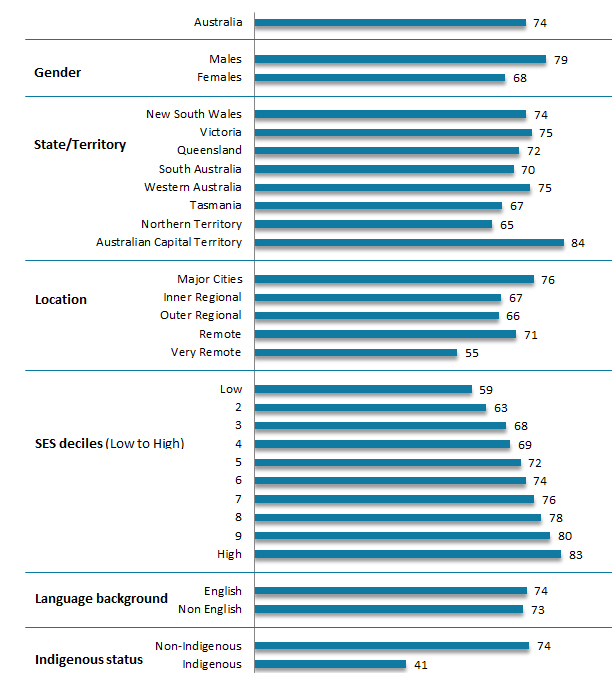Post-school years: Many 24-year-olds marginalised but second chances help

Just over one-quarter of all young Australians at the age of 24 are not engaged in full time work, training or study. This translates into annual cohorts of over 90,000 young Australians in their mid-20s struggling to establish stable study and work careers.
But many who were not on track at age 19 are able to find a pathway by age 24 through training and apprenticeships.
Educational opportunity in Australia 2015 is one of the most comprehensive data studies of Australia’s education system. It examines young people’s progress on four key educational milestones, from the early years right through to young adulthood. In this fact sheet we look at the post-school years milestone, when young people are aged 24.
Key findings
- Slightly less than three-quarters (74 per cent) of young Australians are engaged in full time education, training or work at age 24. This means around 93,000 young people marginalised from education and employment options.
- Gender differences in engagement at age 24 show about a 10 percentage point gap, with females much less likely to be fully engaged in study and paid work at this age. This is partially due to young women engaged in domestic unpaid work, such as child-rearing or caring responsibilities.
- Indigenous young people are missing out in disproportionately large numbers at this milestone. Only 41 per cent are engaged in full time work, training or study, compared to 75 per cent of non-Indigenous students. This is a wider gap than at the previous school completion milestone.
- Socio-economic status remains influential, with only 59 per cent of the most disadvantaged young people engaged full time, compared to 83 per cent of the most advantaged.
- Location remains a key factor, with only 55 per cent of young people in very remote communities engaged in full time work, training or study, compared to 76 per cent in major cities.
- Vocational education and training (VET) plays a critical role during this period. By age 24, roughly 50 per cent of all young Australians enrol in a VET course, and about 36 per cent complete their study.
- Over one quarter of all young people gain an apprenticeship or traineeship. This pathway is particularly important for early school leavers, with 46 per cent of them commencing an apprenticeship by their early 20s.
Percentage meeting this milestone at age 24

Graph text alternative:
Graph showing the percentage of young Australians who meet the milestone 'engaged in full time work, training or study' by the age of 24. The data shows that 74 per cent of young Australians meet this milestone and then shows percentages by gender, state/territory, location, SES deciles, language background and Indigenous status impact. The results are as follows: Gender - 79% of males, 68% of females; State/territory - ranging from 65% of those in the Northern Territory to 84% of those in the Australian Capital Territory; Location - ranging from 55% of those who live in very remote locations to 76% of those who live in major cities; SES deciles - a general increase as SES decile increases, from 59% low to 83% high; Language background - 74% English, 73% non-English; Indigenous status - 74% non-Indigenous, 41% Indigenous.
Source: Educational opportunity in Australia 2015 , CIRES for the Mitchell Institute
What does this tell us?
Participation in education, training and work is often used as an indicator of the well-being of young people. Research suggests that young people who are not fully engaged in education or employment (or a combination of both) are at greater risk of unemployment, cycles of low pay, and employment insecurity in the longer term. Participation in education and training, and engagement in employment, are considered important aspects of developing individual capability and building a socially inclusive society.
The majority (73.5 per cent) of young people aged 24 years (from a total of around 350,000) are fully engaged in either education or work. Those who are not able to secure full-time work or engage in study or training are disproportionately likely to be Indigenous, female, and come from a low SES background.
About one-quarter of 24 year-olds are not working or studying full-time, but many are also getting back on track especially through VET and apprenticeship training.
The overall picture conceals the different pathways taken by young men and women during this period, as evidenced by the larger proportion of young men who are able to meet the milestone at age 24 than young women. The research suggests that many women take on caring and family responsibilities at this point in their lives, and are more likely to be working part-time.
University plays a very important role in the lives of young people making the transition from school. While 50 years ago, it was the preserve of only a small proportion of school leavers (less than 5 per cent), today it involves over 40 per cent. Even so, it remains the preserve mainly of the wealthy. Only 17.3 per cent of young adults from the most disadvantaged backgrounds (lowest socio-economic decile) attend university. The opportunity for higher education study, and the professions to which it often leads, is far from evenly shared, despite our national goals to make it more open.
There is no denying that Vocational Education and Training (VET) is playing a key role in creating second chances for those who have been off track at other milestones, particularly students from low socio-economic backgrounds and in regional and remote areas.
Previous work by the Mitchell Institute has charted the persistent disinvestment in VET in Australia over the past decade, and the apparent lack of strategy in our investment across the education continuum. Mitchell has also argued for a simpler and fairer financing framework across tertiary education, to enable all young Australians to gain the skills and capabilities they need to contribute effectively to Australia’s future.
This new research reinforces Mitchell’s view that future education reforms must look at the education system as a continuum rather than as isolated sectors, and that VET plays a critical role for many people throughout their lives. This is particularly true during the transition to early adulthood, when young people are vulnerable to disengagement and unemployment. Second chance opportunities through VET need to be acknowledged as an important part of the tertiary education system and a valuable pathway option available to all.
What did we measure?
The Post-school years milestone looked at how many young people were engaged in full time work, training or study at age 24, using ABS Labour Force data.
Fact sheets in this series
- Fact sheet 1 – Socio-economic disadvantage and educational opportunity persistently linked
- Fact sheet 2 – Early years: Gaps in educational opportunity evident at entry to school
- Fact sheet 3 – Middle years: Achievement gaps widen at Year 7
- Fact sheet 4 – Senior school years: School completion uneven across Australia
- Fact sheet 5 – Post-school years: Many 24 year olds marginalised, but second chances help
- Fact sheet 6 – Young people in rural and remote communities frequently missing out
More information
Educational opportunity in Australia 2015 was prepared by the Centre for International Research on Education Systems at Victoria University for the Mitchell Institute.



